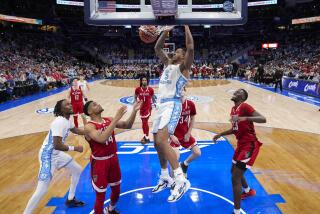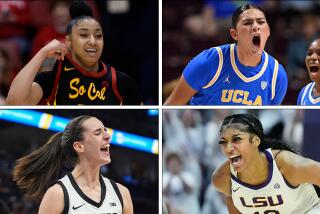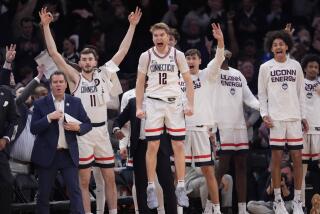CLOSE CALLS BUT NO FALLS
It could happen. It will happen. It just hasn’t happened.
Since the NCAA men’s tournament field was expanded to 64 teams in 1985 and teams in each of the four regions were seeded 1-16, no top-seeded team has lost its first-round game.
West Regional No. 1 UCLA (31-3) opens tournament play Thursday night against No. 16 Mississippi Valley State (17-15) and it’s quite probable that Bruins Coach Ben Howland has mentioned some of these games:
In 1989, No. 1 Oklahoma 72, No. 16 East Tennessee State 71; No. 1 Georgetown 50, No. 16 Princeton 49. In 1990, No. 1 Michigan State 75, No. 16 Murray State 71, in overtime. In 1996, No. 1 Purdue 73, No. 16 Western Carolina 71. In 2006, No. 1 Connecticut 72, No. 16 Albany 59 -- after Albany led by 12 points in the second half.
It is Princeton’s near-win over Georgetown, which had Alonzo Mourning at center, that remains vivid for many college basketball fans. When the tournament draw was revealed that season, Princeton coach Pete Carril said, “I think we’re a billion-to-one shot to win the whole tournament. But I think to beat Georgetown we’re only 400 million to one.”
That almost turned into a good bet.
In the last six seconds, Princeton had the ball and had two shots for the win. The first was taken by Bob Scrabis, the Ivy League player of the year, and the next, after an inbound pass, by Kit Mueller with one second to play. Mourning blocked both.
“We prepared for the game as if it were just another Ivy League game,” Scrabis said. “We were preparing to win. One problem was that in practice our second team was told to play defense the way Georgetown did and we were having trouble getting a shot off against our second team.”
Once the game started, though, Princeton became more confident.
“We were playing against a team that would have four or five guys in the pros pretty soon,” Scrabis recalled. “. . . Charles Smith was covering me and I could tell he wasn’t completely into it. It was like they didn’t understand what was going on, felt like they could coast here a little bit and then just turn it on.”
Georgetown’s scare came a night after East Tennessee State led top-seeded Oklahoma by as many as 17 points before scoring only three points in the final five minutes of the game. Mookie Blaylock made a baseline drive to give Oklahoma its second lead, 72-71, with 1 minute 21 seconds left and East Tennessee State missed twice in the closing minute.
The game was played in Nashville and Keith “Mister” Jennings, point guard for the Buccaneers, said crowd support mattered.
“We walked onto the court in our warmups and stopped because the crowd was going crazy,” Jennings said. “The looks on their faces, it was like, ‘Why are they caring about this team.’ We didn’t understand the whole underdog concept.”
As the game progressed and East Tennessee went ahead, Jennings said, “I looked at myself and was sizing myself up and saying at first, ‘Wow, I at least look like I belong.’ And then it was, ‘Wow, I can hold my own against these guys.’
“But then there was a point in the second half when we started to play not to lose instead of playing to win. It wasn’t a conscious thing, it just started to happen.”
A year later, Murray State’s Popeye Jones scored 37 points against Michigan State, showing that one spectacular player could almost take down a team. When the game went to overtime, though, Jones was exhausted.
It took another six years before a No. 16-seeded team came close again -- and it was against another Big Ten Conference team, Purdue.
Boilermakers Coach Gene Keady recalls his stomach turning over as Western Carolina had a three-point shot in the final seconds for a chance to win, missed, got the rebound, and had a two-point shot to tie.
“Our heads were not in the right place from the start,” Keady said. “We were all caught up in having won the Big Ten title, thought we were hot stuff and that almost got us beat. I found myself thinking that thought. ‘You’re going to be the guy who goes down in history, losing to the 16.’ Oh my goodness, I was worried.”
In the next nine years and 36 games between 1 and 16, 16 were won by 30 points or more and 11 by at least 20 points.
But in 2006 the Great Danes of Albany grabbed hold of a 12-point lead over Connecticut in the second half.
Albany Coach Will Brown said, “By the time the game started, we had a chip on our shoulders. We were tired of reading how we had no chance, tired of the chuckles about us. All I said was, ‘If you can keep this close, you can win.’ ”
The score was still tied with five minutes to go.
“Then fatigue set in,” Brown said. “Our guys got caught up in looking at that scoreboard and going, ‘Whoa, this could happen.’ We just ran out of gas.”
Princeton’s Scrabis is convinced a No. 16-seeded team will someday win a game.
“You’d have to play the perfect game and we didn’t,” he said. “No missed foul shots, no errant judgments as far as taking shots too quickly or turning it over. But it has to happen someday. I think it will.”
That’s what Howland is telling the Bruins.
--
--
(BEGIN TEXT OF INFOBOX)
Two extremes
The closest outcomes and biggest blowouts in No. 1 vs. No. 16 games since the tournament went to 64-team field in 1985. For all games between No. 1 vs. No. 16 teams see www.latimes.com/sports.
CLOSEST GAMES
1989: Oklahoma 72, East Tennessee State 71
1989: Georgetown 50, Princeton 49
1996: Purdue 73, Western Carolina 71
BIGGEST BLOWOUTS
1998: Kansas 110, Prairie View 52
1995: Kentucky 113, Mt. St. Mary’s 67
More to Read
Go beyond the scoreboard
Get the latest on L.A.'s teams in the daily Sports Report newsletter.
You may occasionally receive promotional content from the Los Angeles Times.






